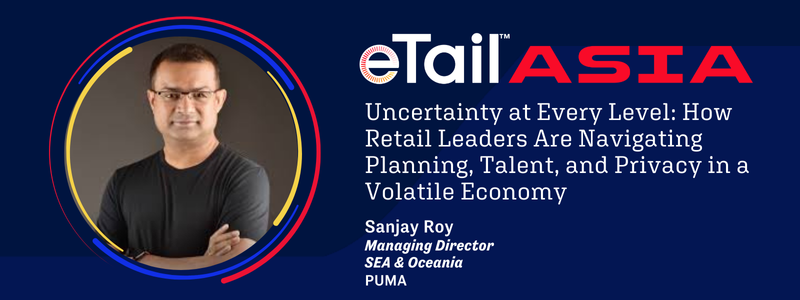Uncertainty at Every Level: How Retail Leaders Are Navigating Planning, Talent, and Privacy in a Volatile Economy

In today’s business environment, stability can no longer be taken for granted. From geopolitical tensions to structural shifts in consumer behaviour, retail and brand leaders across Asia face a difficult truth. The assumptions that guided business planning for the last decade no longer apply.
Sanjay Roy, Managing Director SEA & Oceania, PUMA, reflects on these challenges while emphasizing how the company is actively reshaping its approach to stay ahead of disruption across forecasting, talent, consumer engagement, and technology.
1. Forecasting in a World That Won’t Sit Still
"One of the key issues I’ve been grappling with—something I imagine many other business leaders are facing as well—is the constantly shifting economic landscape."
Volatility, both regional and global, has made traditional planning increasingly fragile. From inventory decisions to sales projections and manpower planning, forecasts are being upended faster than teams can respond.
"Whether it's the U.S.-China tensions, conflict in the Gulf, or other macro factors, it's becoming extremely difficult to plan for the future."
The impact is tangible: business cycles are shortening, and the margin for error is growing.
"The frequent changes in business dynamics over short periods are leading to major forecasting errors."
Rather than being constrained by this uncertainty, PUMA has pivoted towards dynamic planning. The company is embedding agility into its frameworks, ensuring that forecasts are not static exercises but living models that evolve with market shifts. Direct-to-Consumer data and online analytics are leveraged for near real-time demand sensing, allowing course correction before risks escalate.
Cross-functional collaboration reinforces this agility. Back-office, revenue, and brand teams streamline go-to-market strategies to maintain both speed and accuracy in execution.
Technology is also being used proactively. By automating processes, Sanjay notes, PUMA is reducing reliance on manual, time-intensive tasks and redirecting capacity towards higher-ROI activities — a deliberate step towards building resilience.
2. Singapore’s Growing Talent Dilemma
Beyond global volatility, local labour dynamics are emerging as a pressing challenge particularly in Singapore.
"Another area that’s particularly relevant to Singapore is the growing challenge of talent availability, specifically, local talent."
While Singapore remains a strategic hub, tightening talent supply is raising questions about long-term sustainability. Recent studies revealed that 54.8% of employees intend to leave their current employer within three years, and notably, 40.8% of these are highly engaged employees. Key factors include lack of timely recognition, limited career development opportunities, and a need for more inspiring leadership.
"It seems increasingly difficult to find and retain qualified local professionals."
For PUMA, this challenge has underscored the need to reimagine leadership and talent development. Rather than waiting for labour pressures to intensify, the company is exploring new ways to recognize achievement, build career pathways, and strengthen its long-term talent pipeline — making resilience in people strategy as critical as resilience in business planning.
3. A Slowdown Few Are Willing to Acknowledge
Singapore’s economic outlook may appear stable on paper, but retail leaders see a more sobering reality.
"Yes, the slowdown of the Singapore market is another area of concern."
Markets such as Singapore and Hong Kong, often seen as bellwethers for Asia’s consumer economy, are facing what appears to be a prolonged downturn.
"Singapore and markets like Hong Kong seem to be going through a rough patch."
At the retail level, the pressure is palpable.
"The macroeconomy may look fine on paper, but retail has been under pressure for the past few years. There doesn’t seem to be much movement or recovery."
Instead of waiting for recovery, PUMA is leaning into new growth levers. Experiential retail formats are being introduced — flagship stores designed as hybrid spaces that combine product showcases with community events, athlete activations, and ambassador-led engagements. Parallel investments in e-commerce ensure a seamless consumer journey across online and offline, reinforcing brand stickiness even in softer markets.
4. AI, CRM, and the Privacy Dilemma
While macro challenges dominate headlines, the intersection of AI, customer data, and regulatory compliance is equally pivotal.
"With increasing regulations like those in Europe, how are brands handling consumer data responsibly while still creating intelligent, personalized experiences?"
PUMA is taking a proactive stance here as well. From experimenting with AI-powered tools such as the Feet Scanner to exploring AI-driven personalization, the company is seeking to elevate consumer experience while remaining firmly aligned with global privacy standards.
Leading Through the Fog
Periods of clarity allow leaders to rely on static forecasts and familiar playbooks. But when every variable — from economic stability to data governance — becomes a moving target, leadership requires a new mindset.
PUMA’s approach illustrates how retail brands can shift from reacting to disruption towards anticipating it. By embedding agility in planning, rethinking talent strategies, innovating in consumer engagement, and using AI responsibly, the company is not just weathering uncertainty — it is building resilience as a competitive advantage.